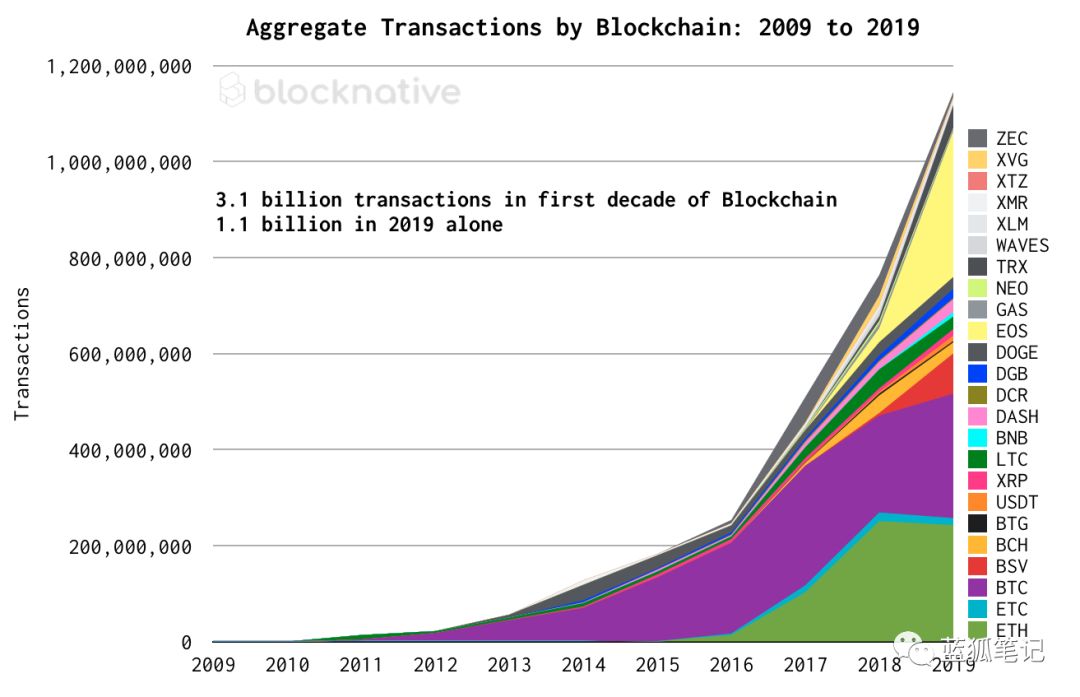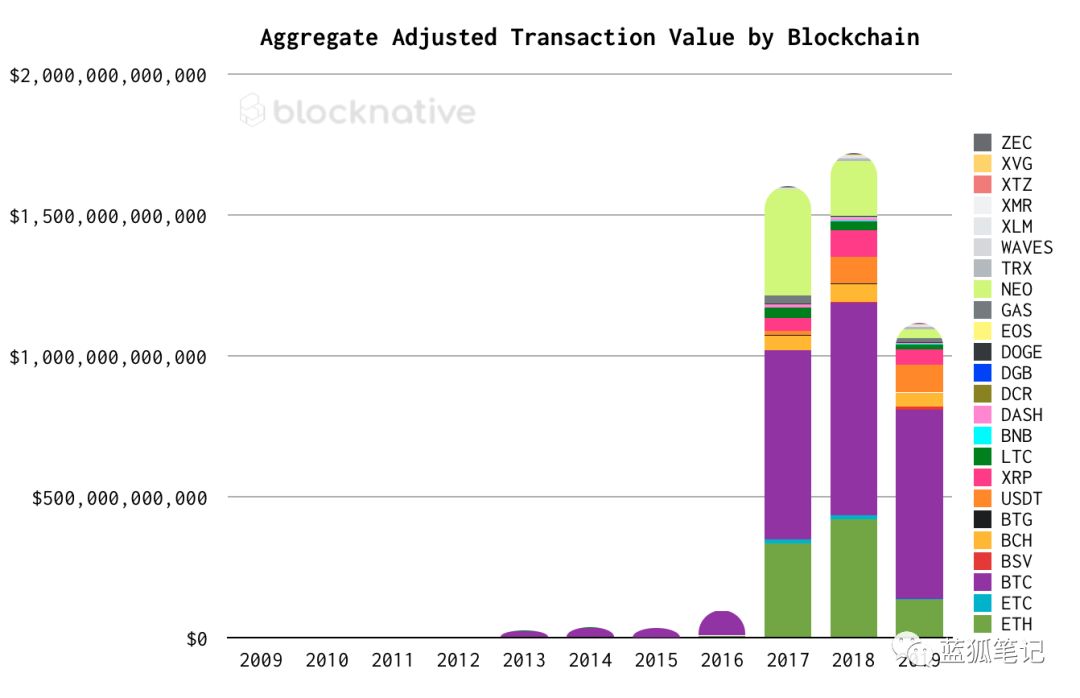When will 1 billion Ethereum transactions occur?
Foreword: The number of Ethereum transactions in 2019 is 242.8 million. When will it break through the 1 billion annual transactions? Can we achieve this goal in three years? The core is the supply-side developers, including the development of ETH2.0, and the development of the ecosystem around ETH (such as DeFi, games, etc.). It may seem difficult to achieve the goal today, but once the tipping point is broken, it may not be impossible. The writer is Matt Cutler of Blocknative, translated by "SIEN" from the "Blue Fox Notes" community.
Web 3 is taking root, moving from proof of concept to enterprise solutions. The Blocknative team reviewed 2019 and tried to understand: "How many public chain transactions have been made so far?" This quickly led to another question: "How many new public chain transactions can we reasonably expect to happen in the next few years?"
Surprisingly, to our knowledge, no one has posted answers to these questions. So we decided to do it ourselves. Here are the results we found.
The results were surprising, exciting, and encouraging.
After a lot of searching, we found blockchain transaction data from CoinMetrics. Using this data as the basis for our modeling and verifying our methods and assumptions, we built the first census of every public chain transaction in the ecosystem, that is, all transactions since the birth of the Bitcoin Genesis block.
- Is this really decentralized? Community announces the destruction of $ 132 million EOS, Block.one is unaware
- Viewpoint | Does Blockchain Need Traffic Thinking?
- Babbitt Column | Can courts effectively penalize mining pools to roll back bitcoins to correct lost and stolen coins?
10 years, 3.1 billion transactions
Over the past decade, the total number of blockchain transactions has exceeded 3.1 billion. It is worth noting that in 2019, the threshold of one billion transactions per year was exceeded. In fact, more than 37% (> 1.1 billion) of the total number of historical blockchain transactions occurred in 2019. The growing trend is gratifying:
 (Summarized transactions of the blockchain from 2009 to 2019, source: Blocknative, CoinMetrics)
(Summarized transactions of the blockchain from 2009 to 2019, source: Blocknative, CoinMetrics)
The above data set includes 24 public chains with the largest annual transaction volume, including: Ethereum, Ethereum Classic, Bitcoin, Bitcoin SV, Bitcoin Cash, Bitcoin Gold, Tether, Ripple, Litecoin, Binance Coin, Dash, Decred, DigiByte, Dogecoin, EOS, GAS, Neo, TRON, Waves, Stellar, Monero, Tezos, Verge, and Zcash.
In 2019, Bitcoin (259.2 million times) and Ethereum (242.8 million times) accounted for 44% of the total number of global blockchain transactions. From 2009 to 2019, the blockchain industry has driven a total value transfer of more than $ 4.6 trillion. 96% of these occurred between 2017 and 2019.
 (The adjusted transaction value of each blockchain is aggregated, source: Blocknative, Coin Metrics)
(The adjusted transaction value of each blockchain is aggregated, source: Blocknative, Coin Metrics)
Note that the total value transfer appears to be related to the underlying asset price. (Blue Fox Note: Mainly cryptocurrencies are extremely volatile)
When can the annual number of Ethereum transactions exceed 1 billion?
Overall, the five-year compound growth rate of the blockchain industry is 44%. Simply make an assumption. If the current trend can be sustained, this means that the industry is expected to have nearly 20 billion new blockchain transactions in the next five years:
 (Linear Blockchain Transaction Volume Growth Forecast)
(Linear Blockchain Transaction Volume Growth Forecast)
At this rate, Ethereum and Bitcoin, and perhaps EOS, will break the threshold of 1 billion transactions per year by 2023. However, I suggest we have reservations about this forecast, because our future will not follow the forecast of linear growth, let alone practical restrictions, such as block size. (Blue Fox Note: There are many possibilities in 3 years, including non-linear breakthroughs in technology)
Having said that, then, when will Ethereum break through the threshold of 1 billion transactions? What drives it? Will the widespread adoption of various layer 2 solutions drive transaction growth and also confuse this type of data aggregation? Or will ETH2.0 be a catalyst for explosive demand for on-chain transactions?
Although we want to focus on when Ethereum will cross this threshold, we think it is more important how to achieve it. Joe Rubin sets the goal of bringing millions of developers to the Ethereum ecosystem. This is critical because we believe that these developers will create experiences that attract new users and drive the realization of 1 billion transactions.
In other words, millions of developers focus on the supply side of our industry, including education, tools, and support to help developers start building. One billion transactions are focused on the demand side. In many ways, these are two sides of a coin.
And, as we saw at ETHDenver 2020, builders are busy exploring the next generation of technology. These methods have the potential to enable entirely new types of transactions that would not exist without the blockchain. We believe that these non-linear innovations can drive our industry to exceed 1 billion transactions by 2023.
Risk Warning: All articles of Blue Fox Notes can not be used as investment advice or recommendations. Investment is risky. Investment should consider personal risk tolerance. It is recommended to conduct in-depth inspection of the project and make good investment decisions.
We will continue to update Blocking; if you have any questions or suggestions, please contact us!
Was this article helpful?
93 out of 132 found this helpful
Related articles
- Bitcoin has been hit hard for 14 hours and has fallen by 14%.
- Analyst observations | What is the correlation between Bitcoin and other assets?
- Bitcoin ETF rejected, "crypto mom" accuses SEC of "switching standards"
- Interview with Crypto Mom SEC Commissioner Hester Peirce: Analysis of Safe Harbor Proposal
- DeFi is about to welcome zk-SNARK privacy technology without trust: what is Supersonic's solution?
- Bitcoin fell below $ 8,600 overnight, and the entire network exceeded $ 879 million
- "True Incense Law" is inevitable, Compound, the DeFi agreement, announced the issuance of governance token COMP to achieve a decentralized governance process




